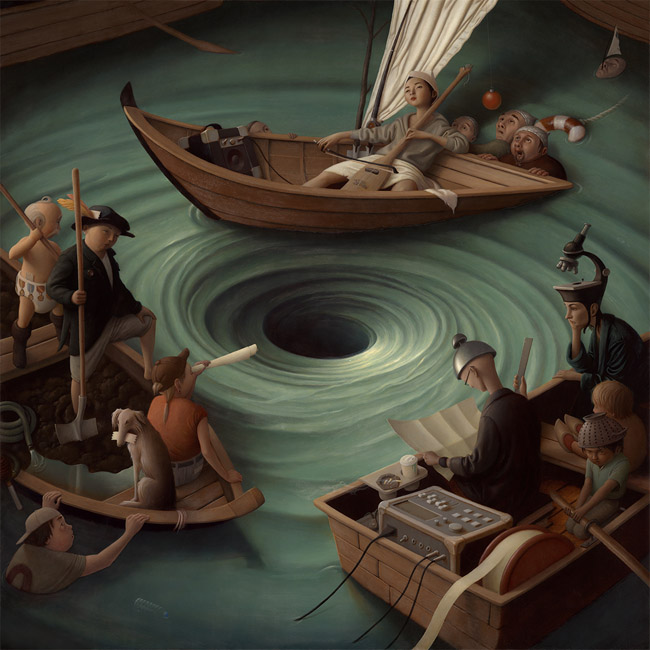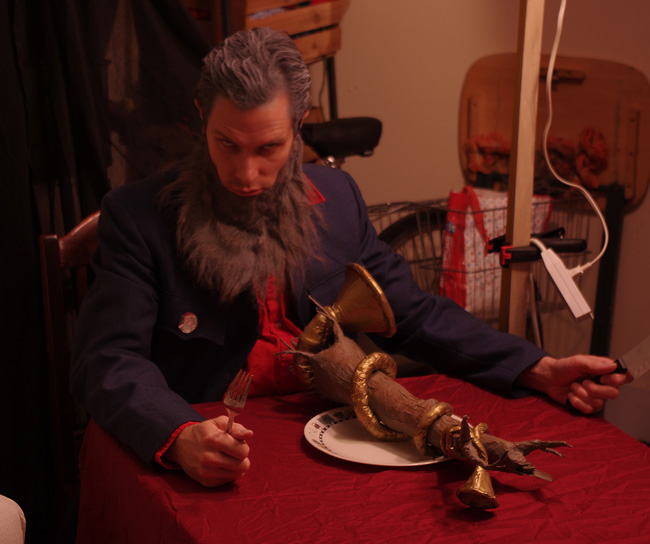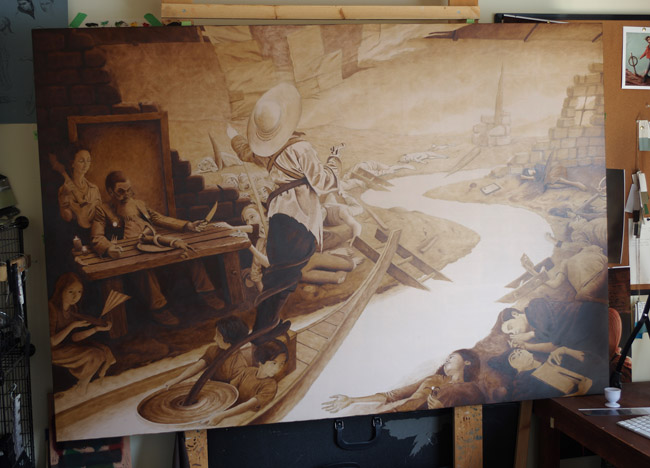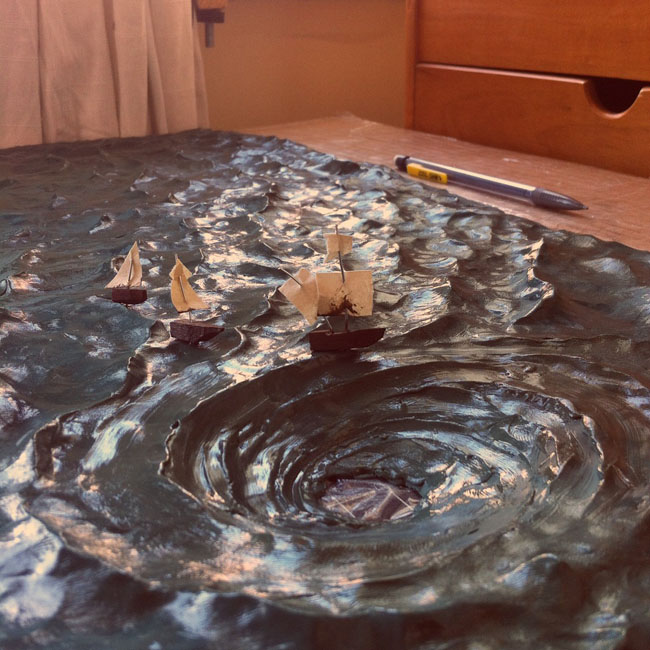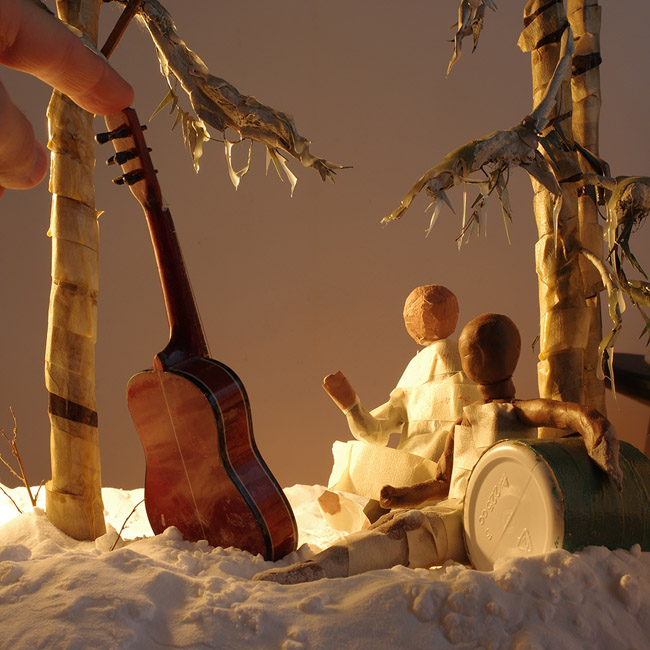I recently had the honour and pleasure of being on the panel of jurors for the Inaugural Beautiful Bizarre Art Prize. In that capacity I was privileged to see a great deal of exceptional art all at once. I found the work of Steve Chmilar, a 2018 Beautiful Bizarre Magazine Art Prize Finalist, exceptional and utterly captivating. For me it had all the hallmarks of outstanding creative work. The particular painting, he chose to submit, had an open ended, intriguing and compelling narrative. The piece was beautifully executed broadly and in every detail. The characters in the painting were fully formed in terms of their demeanour and mood and in the way these contributed to the narrative. The manner in which he painted it, was unique, a style like no other and quite idiosyncratic, making it original. The colour palette was also unusual. And it is not just me who is seeing the strength and quality of this artist’s work.
Not only was he a finalist but he also received an Honourable Mention for his work and it also gained a place as a finalist in the Levine Projects Delusional Art Competition. I was keen to find out more about this exceptional artist and his work. Steven’s detailed responses in this interview are candid, honest, considered and extraordinary. It is a must read for artists and those who want to find out more intimately how an artist thinks and works. So many of Steven’s words resonated deeply with my thoughts and feelings and experiences of the art world. His process is revealed through explanation and in the intimate photographs from his studio. Thank you Steven for this insight into your imagination, process and work.
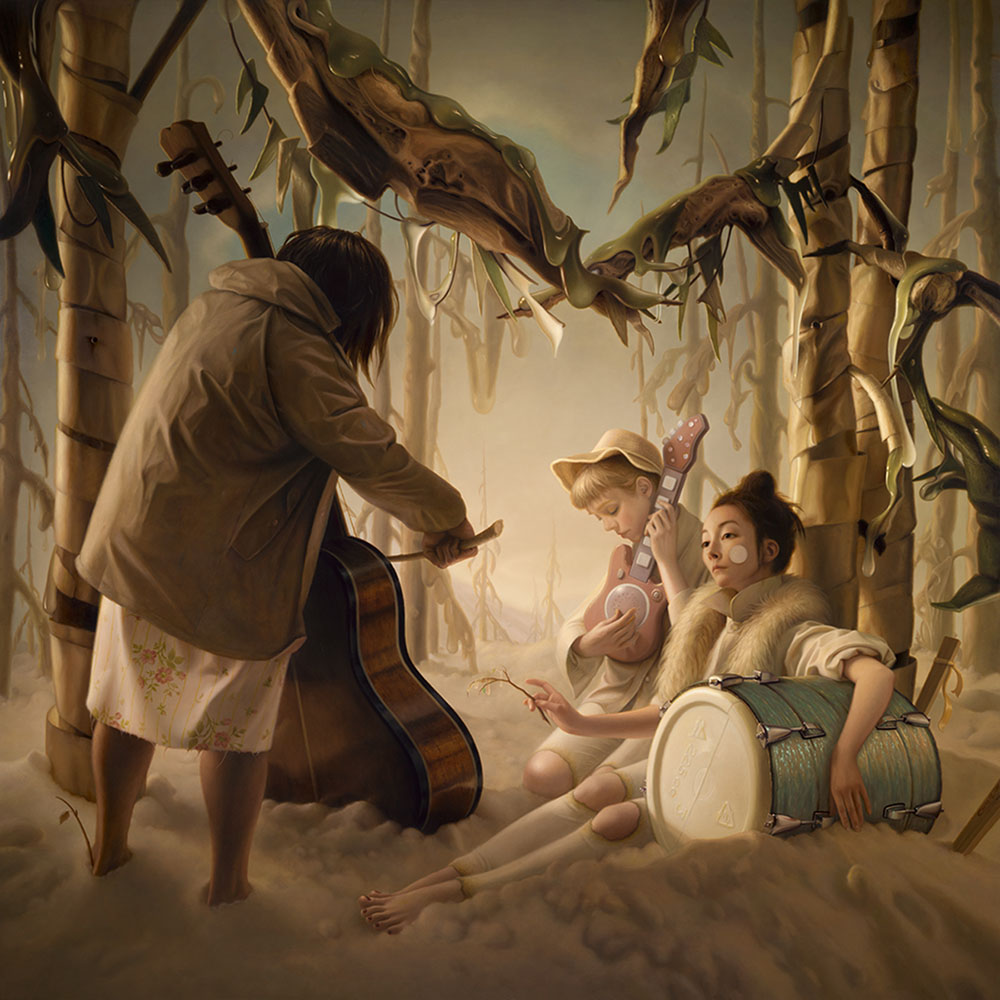
Your very unique vision makes your work truly extraordinary. As an art educator I have often considered the question of what makes a great artist. I believe it is an unfathomable imagination and an exceptional vision. Skills such as rendering and perspective can, to some extent, be acquired through learning and practice, but I have always felt a limitless imagination and a unique vision is a gift bestowed to only a few artists. Would you agree?
Thank you for the compliment. Questions like that have always been at the front of my mind. How common are these gifts and what do they mean? The 10,000 hour rule might be an appealing way for an artist to take all the credit: “I was born a blank slate and decided one day to start working obsessively, going from zero to 100 by my sheer will alone”. I wouldn’t be so quick to say that because I side with Steven Pinker on the topic of blank slates. We are a mix of inherent wiring, social conditioning and acquired abilities. There is a ton of talent in the world, but it means nothing without the motivation that enables us to do the most we possibly can with what we have. If we are humble enough, we can admit to our weaknesses and spend time on what can be improved, not wasting it on everything else. It is a constant personal evolutionary process.
I do think it is absolutely necessary for anyone in a creative field to possess both an unfathomable imagination andexceptional vision to become successful. Absolutely. That is the personal, individual element. The next part is likely how that individual relates to the rest of our culture. It depends on relative standards. I’m sure there are tens of thousands of people living today that could have met the artistic standards of the fourteenth century, but now the expectations are completely different. That is probably obvious to most people reading this interview, but I think it is worth stating. I had thought about that kind of thing when I played music. I felt like an amazing guitarist because I grew up in an industrial town in northern Alberta, Canada. If I had grown up in L.A., I’m not sure if I would have been encouraged or intimidated.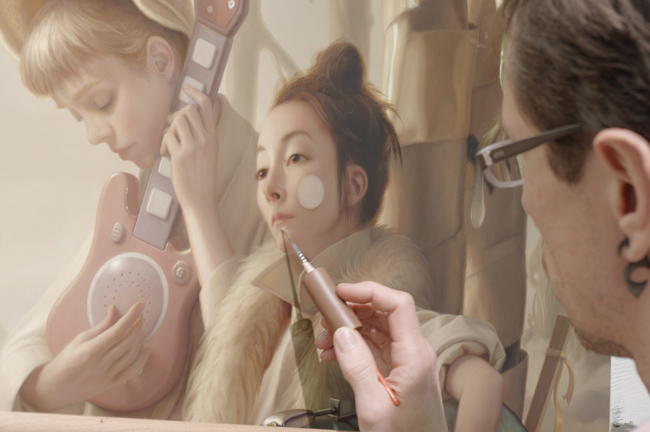

Now, the internet allows us to see all of the best work in one place very quickly. If that is all we see, we can become discouraged by miscalculating a skewed sample size. I won’t say that comparing ourselves to the best of the best isn’t incredibly useful, but it can be a little intimidating if someone is starting out. It’s kind of like gauging the state of the world only by looking at headline news. On some media sources, all of the most terribly violent global events end up on the same daily news cycle, ‘if it bleeds it leads’. All of the great things that happened that day aren’t reported because it isn’t considered news. A vaguely similar example of sample or confirmation bias. “See, I told you everything is terrible”. An artist could say: “see I told you I won’t stand a chance”. It skews our perception. If we only see select samples of the best work by the best artists, and not all of their early work that lead up to that ability, we may think that everything we do has to be perfect on the first try.
Another question might be: is the ratio the same now as it always was? Was the percentage of working painters in Florence circa 1500 the same as in today’s cities? I have more questions than answers but I would bet one certain thing is that it is a matter of ubiquity versus rarity. Once something becomes extremely common it loses its “wow factor”. We become desensitized to it. The instant appeal is always there for new mediums or flashy first-time-tech reveals, but there is something deeper that never loses its effect, regardless of medium. Perhaps that something is whatever is truly rare or difficult. People always appreciate what they would like to be able to do but can’t. Those people make up the market that is an ‘invisible hand’ and that determines what will be appreciated, seen and produced. Despite whether or not someone is in favour of the monetary system, it would still apply in a post-monetary world. The most valuable wall-space in a Utopian-Future-State-public-art-gallery-type-of-space would go to the work that most people would agree should be there. Regardless of whether or not that artwork would have a price tag on it, there is always a price. It doesn’t matter whether we can put that price in dollars, pounds, time allotted or earned respect.
I think the artists bestowed with a rare ability to capture sustained attention today are going further and deeper because that is the only place to go when “everything has been done” in a simple aesthetic sense. Anything less that the very best of a talented artist’s full-life commitment is a known quantity and artists are responsible for converting unknown quantities into something perceivable. It is our burden to walk into a jungle without the machete that a predictable wage provides. If we don’t have some rashes and scars from thorns and poisonous plants, then we probably haven’t walked into the right parts of that jungle. The densest most dangerous parts hold the best kept secrets. When these secrets are properly converted into something that can be seen by many, it gets the attention it deserves.
How do you ‘lock onto’ and develop your imagination, as an artist, and develop a unique vision in representing the external or internal world.
It is difficult to explain where exactly my initial ideas come from. They just happen in some way. I think I might have synesthesia. A long time ago, before I knew what that was, I tried to make a classroom presentation on what different music intervals and chords looked like by representing them with colors. A major third harmony has always been kind of orange to me. That is all I can say about these initial visions in my mind. I would love to try and dive deeper into that topic later, but for now, I may just have to talk about the tactile elements that happen after the impetus of my ideas.
In order for an idea to make it from a split-second spark to a fully realized, multi-week painting, it has to make it through a multi-stage screening process (ooh, that sounds so official). My “multi-stage screening process” is as follows:
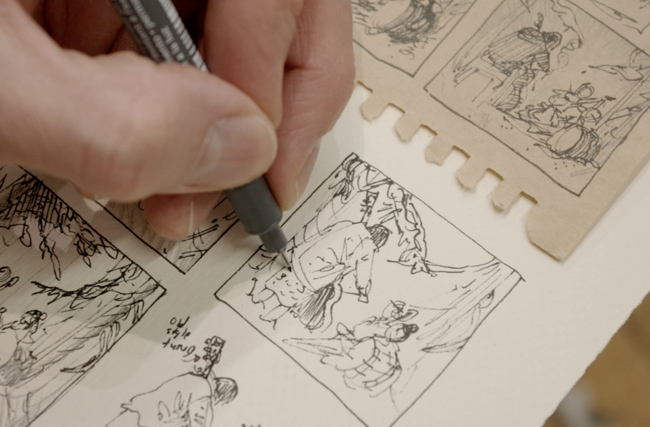 In the first instance, it has to be of subject matter that feels pertinent to my current thought-space. Secondly, it has to excite me in terms of basic composition. The tiny thumbnail sketch must have a great feeling in terms of general shape and flow. Third, it has to fit into the progression of my career, moving things forward just enough without losing my past, retaining some continuity without becoming stale. Fourth, and this may be the toughest for most artists, is how it relates to the market. That is a general idea. There may be other small factors at play as well, such as size. I may be in the mood to only paint huge multi-figure paintings, but a smaller one or two between larger ones are more affordable and easier to ship to group exhibitions. I may be in the mood to move on to that next large one, but saving it for later makes me move faster through the present work.
In the first instance, it has to be of subject matter that feels pertinent to my current thought-space. Secondly, it has to excite me in terms of basic composition. The tiny thumbnail sketch must have a great feeling in terms of general shape and flow. Third, it has to fit into the progression of my career, moving things forward just enough without losing my past, retaining some continuity without becoming stale. Fourth, and this may be the toughest for most artists, is how it relates to the market. That is a general idea. There may be other small factors at play as well, such as size. I may be in the mood to only paint huge multi-figure paintings, but a smaller one or two between larger ones are more affordable and easier to ship to group exhibitions. I may be in the mood to move on to that next large one, but saving it for later makes me move faster through the present work.
To quote Vincent Desiderio, it is a matter of “quality control”. I’m sure all artists have a lot of drawings they would never show anyone. I feel the same about ideas; I have a lot that I think may be deserving of a small sketch but not as many that should become a large painting. Hundreds of hours can make something technically impressive but that doesn’t make the idea any better. I love great ideas. They feel like the essence of life. I get so excited by thoughts about my upcoming artworks, no matter where I am. That excitement used to happen with music as well. I would come up with a new riff and sometimes feel like the sky just opened up and a thousand tiny sun-puppies start dancing on the hairs on the back of my neck. For an explanation of what sun puppies are, refer to chapter 83.9 in the about section of my website. Zam.
I want an idea to reflect something that I feel is both critically important but simultaneously under-represented. This may be subtle in my work, but it is at least a starting point of a narrative that usually becomes subordinate to aesthetic choices. The end result may be mostly guided by colours and composition but at least I know there is something deeper behind it. It changes for each painting. I could probably write a different interview for each piece.
Here is an analogy from music that could help to explain: I used to play guitar and sing in a three piece band and as a one man band in bars and pubs. My passion was always writing my own music, but cover gigs were a great way to pay the rent and keep skills sharp. After a while, you develop a sense of exactly what people want to hear. You learn a variety of songs to please a variety of people. If it becomes a job, you keep paying the rent by appeasing the crowd. Once we had enough standard songs in our set list, we had a different goal. We wanted to learn the songs that we knew people would like, or should like, but either haven’t heard yet or forgot that they liked. Those are the ideas that excite me. The ones that don’t feel done to death but worth doing none the less. The untapped ones. The secret things that were forgotten about that deserved more attention. The ones left behind. I think that is always the job of an artist, to be a purveyor of possibilities, of things worth thinking about that haven’t been brought to the surface enough yet (fiction authors deal with this very well). Or put another way, to show people things they don’t know they might like until they know it exists.
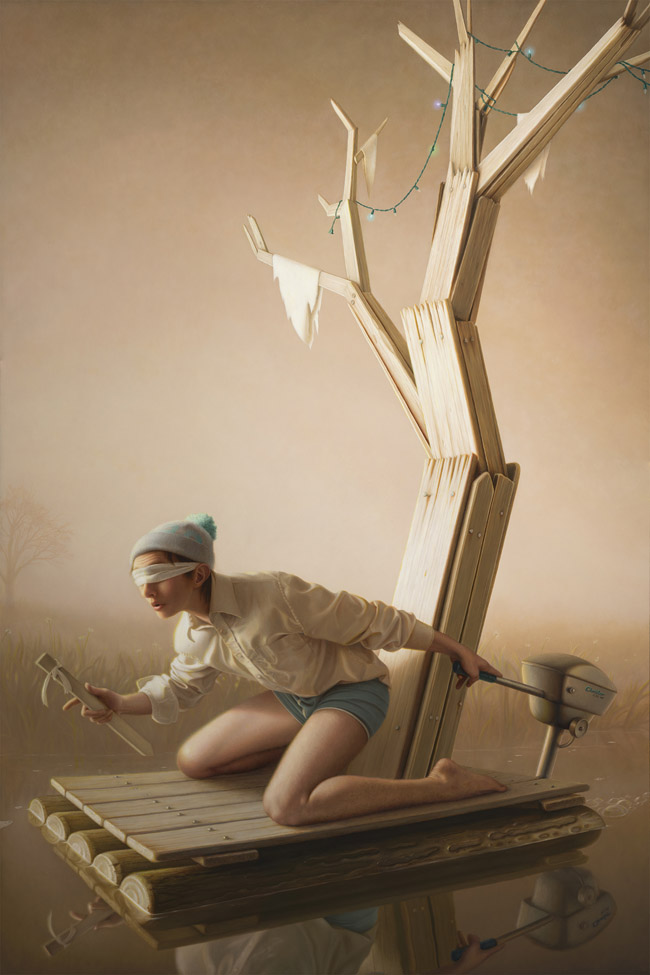
To answer your question about unique vision, I could use the example of a recent painting I created called The Raft. It is about my self-conscious desire to be original or unique. In the painting, the figure is venturing blind, holding a zoning stake, looking for solid ground to mark its ‘creative territory ‘. Surrounded by a swamp-like area, there is no solid ground. I think this painting is symbolic of the feeling we have of creating new things when there is nothing new under the sun. The ‘creative real-estate’ left available is smaller and smaller especially in an old genre like figurative painting. Instead of trying to find a large plot to stake my claim, I think I have found a bunch of tiny plots between other plots that collectively add up to a something. I look forward to continuing that journey.
You paint a fantasy world full of intriguing vignettes, characters and landscapes. Where does the vision of this world spring from? Do you think it’s important to have fantasy in our lives? What do you see as the function of fantasy in your life and in the life of others generally?
The vision for this world comes from deep inside my bone marrow. I’m afraid my answer to this question might be similar to my previous answer. When I close my eyes, I see dead people. Ha. I meant to say, when I close my eyes, I see a painting that doesn’t exist yet.
I draw an important distinction between fantasy and escapism. In this dichotomy, I might define escapism as potentially destructive and fantasy as potentially constructive, generally. If escapism is destructive because it distracts us from the task of repairing or improving our reality, then fantasy is like an exercise in creating possible solutions and envisioning ways that reality could be. (Of course there is dystopian fantasy and I would separate myself from that category). Fantasy can have a proactive function if it is subordinate to reality. If it acknowledges reality through its content. That is a function that painting serves more and more since the dawn of photography. Here’s an analogy: a cat may not swallow a pill unless you break it apart and put it in its food. Pleasing aesthetics or altered versions of reality are like the tasty food, they provide a vehicle for deeper thoughts (the medicine) to slide through the mental esophagus.
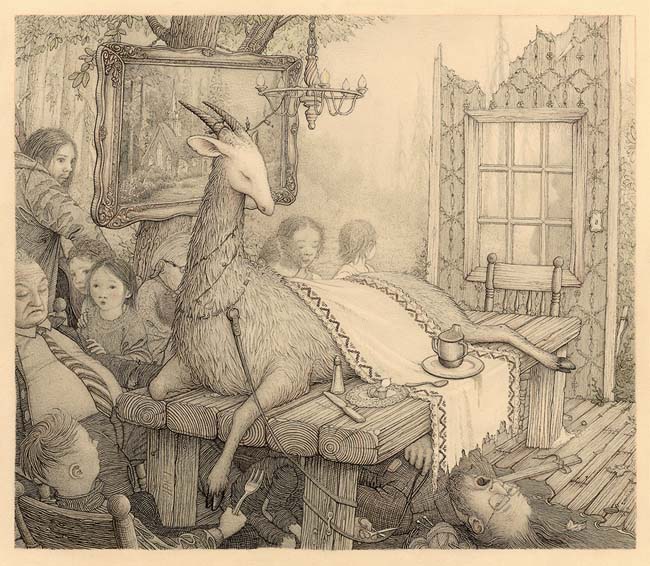
What broad ideas underpin your body of work to date?
Everything matters rather than the opposite. I believe that ‘opposite’ has pervaded our minds like the green gas that surrounds the earth at the beginning of the 1980’s movie Maximum Overdrive. What’s the point? What’s the point of me answering questions in this interview? I can only hope a reader doesn’t feel that way. Ha. Ha, ha, ha ha. From the perspective of an ‘everything matters’ mindset, we understand it is impossible to highlight everything, so we summarize the infinite. We make a greatest hits list out of an unfathomably vast array of choices and deliver it on a silver platter for the eyes.
My intentions are to be grand without being too self-aggrandizing… to take my work as seriously as possible without taking myself too seriously. Yikes, I’ve already ruined that perception. I digress. I will now redirect this thought to an Odd Nerdrum quote: “a kitsch painter wants to create a masterpiece. An artist is more modest, they just want to be accepted”.
I think that ‘broad ideas’ are the key. The incredulity toward meta-narratives or anything that remotely resembles the past within the modern art institutions leaves a representational painter with debilitatingly limited options. If this pressure causes us to be as specific as possible in our ‘brand’ or corner a niche market without ever going outside those boundaries, than it is a declaration of our own smallness. Broad ideas are big, too big. To tackle them is to declare a delusion of grandeur. I have done this. The only way to move forward is to be naive so as to be ignorant of fear and trepidation. Sometimes I think that the divider between naivety and wisdom is thinner than a razors edge. Maybe like a nano-razor?
On a more inspiring note (hopefully), here is a little story: I had spent about three months of 2014 in creative purgatory. Every idea I could possibly come up with received a shotgun blast from my inner critic. I had just finished a show, wrapping up my last couple of years, and wanted to start a new series that would take my career to another level. I had countless ideas but nothing seemed to work because I was my own kryptonite. No other person on the planet would have been able to tear myself apart so voraciously. I was obsessed with the pursuit of my own unique place. I had no option but to go deeper and place the allegiance to my authentic self as the priority over other opinions or influences.
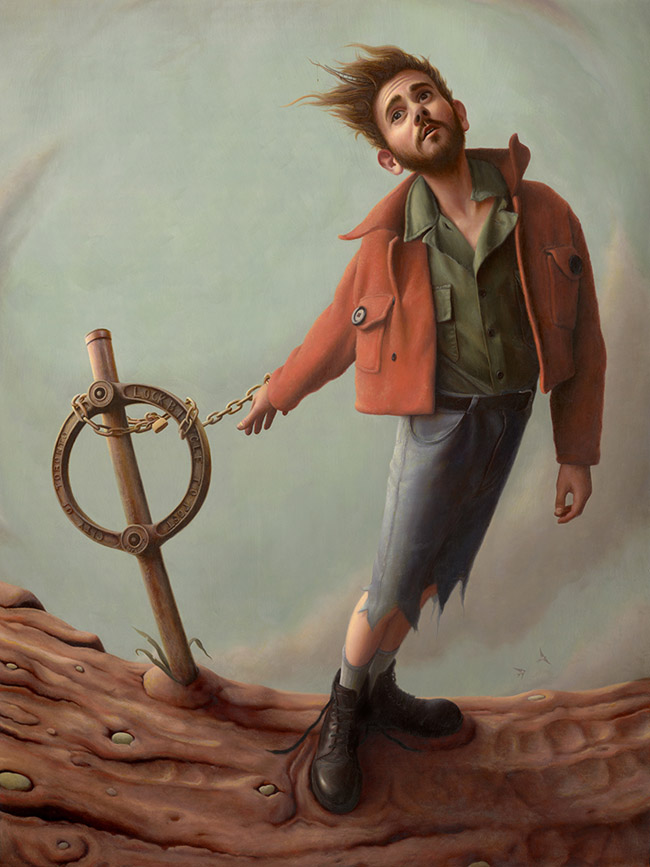 Now, I think the result of my artistic vision has become like the fossa: a carnivore only found in Madagascar. At first glance, the fossa looks like a smaller puma or large weasel, but maybe more like a cat, it’s hard to tell. It is similar enough to a cat to make you think it evolved from a panther or something, but the data was unclear to scientist for decades. It evolved on its own land mass, ending up similar to cat-like carnivores on other continents but not the same. It was uniquely developed for it’s own environment. In the end, it evolved to play a similar role to that of larger carnivores in other parts of the world. Similar but different. That is how I would like to think of my art: evolving alone from an individual place but resulting as something recognisable. From personal to universal.
Now, I think the result of my artistic vision has become like the fossa: a carnivore only found in Madagascar. At first glance, the fossa looks like a smaller puma or large weasel, but maybe more like a cat, it’s hard to tell. It is similar enough to a cat to make you think it evolved from a panther or something, but the data was unclear to scientist for decades. It evolved on its own land mass, ending up similar to cat-like carnivores on other continents but not the same. It was uniquely developed for it’s own environment. In the end, it evolved to play a similar role to that of larger carnivores in other parts of the world. Similar but different. That is how I would like to think of my art: evolving alone from an individual place but resulting as something recognisable. From personal to universal.
Human cultures that did not make contact with each other for eons were unique because of their unintended seclusion. Now, the internet has become a great homogenizer of ideas or creative content. If one art style seems to be more popular than others, we see it over and over again. That is unavoidable and has happened way before the internet so I won’t waste any more energy thinking about it. I’ll finish this thought-salad with my favourite Andrew Wyeth quote: “If I show something to someone and they don’t like it, it’s a bad thing. If they do like it, it’s a bad thing. An artist has to be in-grown to be any good”.
One of the most compelling aspects of your paintings is the narrative quality. The viewer gets the sense that you are a great story teller. The Aesop of painting with fables and allegories. Do you have recurring narratives, characters and scenarios or do you develop these for each new body of work? Is there an overlap? Are these characters or narratives metaphors for broader ideas? Do you think it’s important or helpful for aspiring artists to establish a narrative as part of their artwork’s identity, uniqueness and style?
Thank you, the Aesop of painting with fables and allegories would truly be something to strive for. I will try to live up to that. Perhaps that is where my initial love for Brueghel came from. He was a great storyteller. I think he was looking at the human world as an observer rather than a participant. A seer rather than a seeker. I would be a little hesitant to say I’m doing the same thing but there is a unifying element in my desire to sit on a fence and be an objective observer. Despite the idea that it is not possible for a person to be truly objective without some kind of bias, I think it is something to strive for. To see multiple sides of a story provides more subject matter or grist for the mill.
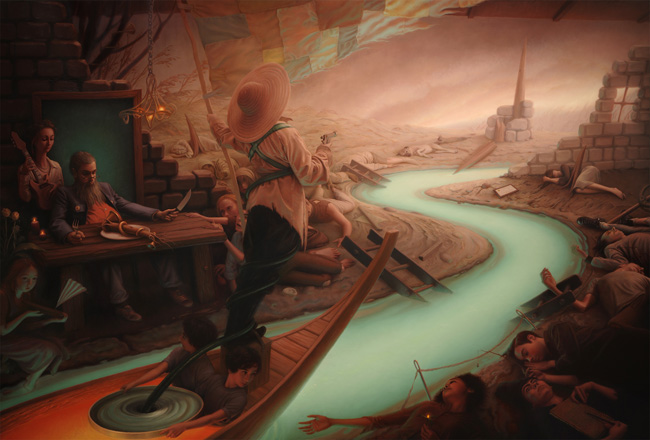
I do have reoccurring narratives in a loosely-knit way. My scenes do not necessarily always include the same group of people in the same space, but this can occur. I get excited about aesthetics first. If a composition strikes me, I find ways to weave it into what I’ve done in previous paintings and drawings.
A large part of me wants to hang onto the idea (like a person scraping their nails into rock while dangling off the edge of a cliff) that all the stories haven’t been told. Of course we know that the general frame-work for storytelling has been repeating a trillion times, but I still think there is enough nuance left to play within the boundaries of the available “creative real-estate”. I’ve heard the sentiment, “why are they re-doing all the old movies, or why are they releasing a cover of that song already”. Creating anything from scratch is a completely different challenge than copying something directly. The cognitive labour is the tricky part.
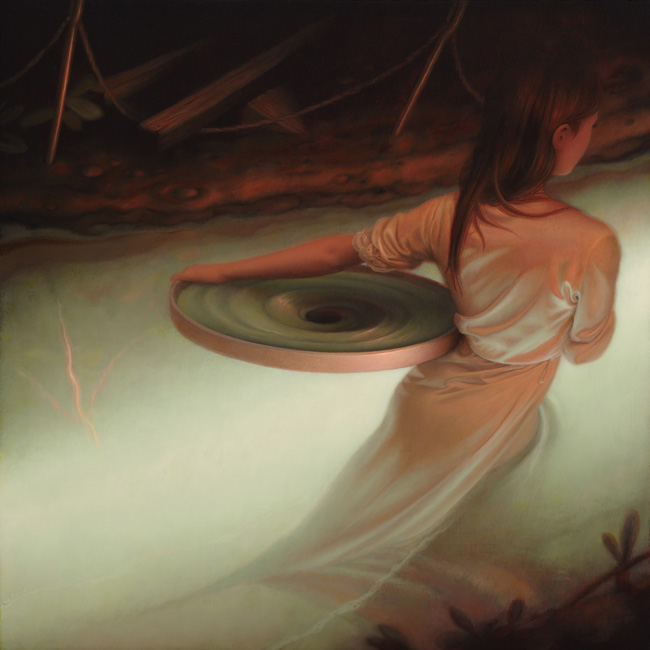 If I have a chance to convey anything to aspiring artists it is not that they should develop a narrative specifically, but more importantly, a few other things. I would forewarn them about how much of a sacrifice is it to be a figurative painter. It takes a great deal of time to work this way. One scarcely has any time left for friends and extracurricular life-stuff, at least if you are doing it for a living. At least from my experience. From what I know, figurative artists clock the most working hours out of many professions (albeit, usually in desirable working environments, so that the trade off). I for one don’t generally ‘hang out’ or ‘kill time’ very often. Life is short and there is art to make. Even if we are oozing with talent and creativity there are no guarantees, so it takes everything we’ve got to have a chance at success in visual arts.
If I have a chance to convey anything to aspiring artists it is not that they should develop a narrative specifically, but more importantly, a few other things. I would forewarn them about how much of a sacrifice is it to be a figurative painter. It takes a great deal of time to work this way. One scarcely has any time left for friends and extracurricular life-stuff, at least if you are doing it for a living. At least from my experience. From what I know, figurative artists clock the most working hours out of many professions (albeit, usually in desirable working environments, so that the trade off). I for one don’t generally ‘hang out’ or ‘kill time’ very often. Life is short and there is art to make. Even if we are oozing with talent and creativity there are no guarantees, so it takes everything we’ve got to have a chance at success in visual arts.
I am intrigued by the use of symbolism in your work, particularly the recurrence of water and the hole or circle, which manifests itself in objects such as picture frames, trays, knots in wood etc and most predominantly as a hole opening up in a sea or land. A vortex down, which we might fall. Could you tell us about this symbol and others in your work? What role does symbolism play in your paintings?
I guess that symbolism is inevitable in any kind of representational art. Anything could potentially mean something and whether we know it or not, we provide signifiers to be interpreted or projected on. If these interpretations turn into conversations, then I consider my work successful. The broader the idea, the more potential there is for deeper discussion. I like broad or ‘big’ ideas that are usually only spoken about in philosophy circles. I have never taken any post-secondary philosophy courses but I love to learn as much as I can for my personal interest.

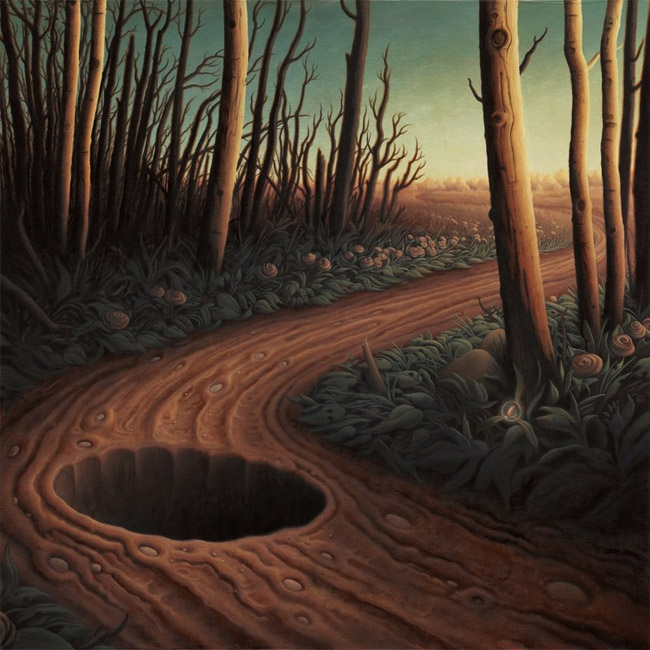 The symbols I have used are sometimes as they appear and sometimes they are merely suggestions to other meanings. The people in my paintings are not supposed to be specific individuals, they instead serve as a symbol for a universal human experience such as an emotion or state of being. For example, a character who is looking in a particular direction could be anybody for the most part. The important factor is that they serve as a vehicle to look in that particular direction. I am always interested more in the content of an individual person’s character than their gender or race. I want to know what goes on behind their eyes rather than what their eyes look like.
The symbols I have used are sometimes as they appear and sometimes they are merely suggestions to other meanings. The people in my paintings are not supposed to be specific individuals, they instead serve as a symbol for a universal human experience such as an emotion or state of being. For example, a character who is looking in a particular direction could be anybody for the most part. The important factor is that they serve as a vehicle to look in that particular direction. I am always interested more in the content of an individual person’s character than their gender or race. I want to know what goes on behind their eyes rather than what their eyes look like.
The whirlpool could point to both positive and negative, infinity and chaos, the end or a new beginning, regress or progress, and so on; a very broad idea indeed. Whirlpools are aesthetically delightful to paint. There are so many potential symbols that might be exciting in the written word that don’t translate well into oil painting. If a symbol is visually ‘fun to paint’ then I might include it. I love having mixed elements and textures like wood, metal, water, flesh, cloth, fur and so on to give a painting more tactile ‘feeling’.
An example of a personal symbol that not everyone might ‘get’, is the zoning stake. I think of it as a symbol for ‘creative territory’. It was inspired by the way that humans claim space through investment in real-estate. A limited resource that cannot easily be created. This metaphor has helped me to deal with my own self-consciousness about originality. In the end, if others don’t ‘get’one of my symbols, than I still consider an artwork a success if it has provoked some thought which translates into viewing time. There may be other symbols that I intentionally haven’t made so obvious so that others can interpret them in their own way.
You spent many years as a professional musician. Has this influenced your view of life and people and how that manifests itself in your work?
Yes. There are endless parallels between visual art and music. I could speak endlessly about the comparisons from music to painting as I’ve done in some other answers. On the business side, I have learned from mistakes as a musician, what to avoid in art. I was inspired by some bands who were able to become successful on their own terms. I think the same thing is happening where painters can sell work independently without only going down established paths. We are still at a time where the remnants from the past have us buying into a preconceived idea of what proper credentials are for an artist’s resume. From the beginning of my career, I have kept in mind that there are many artists who don’t have an ‘impressive’ resume by academic standards that do make a good full-time living. I have redefined my idea of success via real-world experience, and that began when I started playing music professionally.
One cannot look at your work and not be reminded of the paintings of Pieter Bruegel and his allegorical peasant scenes and I am aware of his influence on your art. You said in an interview, “There is also a sense that Bruegel had to have been a philosophical thinker who would have been interesting to talk to. Language barrier and time travel paradox aside, he would be my first choice to have a beer with.” This is a fascinating idea. If you got to have that beer with the artist what do you think you would talk about? What would you like to draw out of him in conversation?
Hmm. Yes. Um…. Well, I’d probably start with,”what was it like to die and what is that all about?” Then I would ask him about the experience of coming back to life. Then, after that I would fill him in on all that has happened in the last 449 years…then, I would take him for a ride in a car, show him an amusement park, skyscrapers, an NBA game, a rock concert, Instagram and virtual reality… then!…I would ask him about his art. I can tell by his work that he would be interesting to talk to. I’m sure he was a curious person who had thought about a great deal of different topics. The conversation would not be boring.

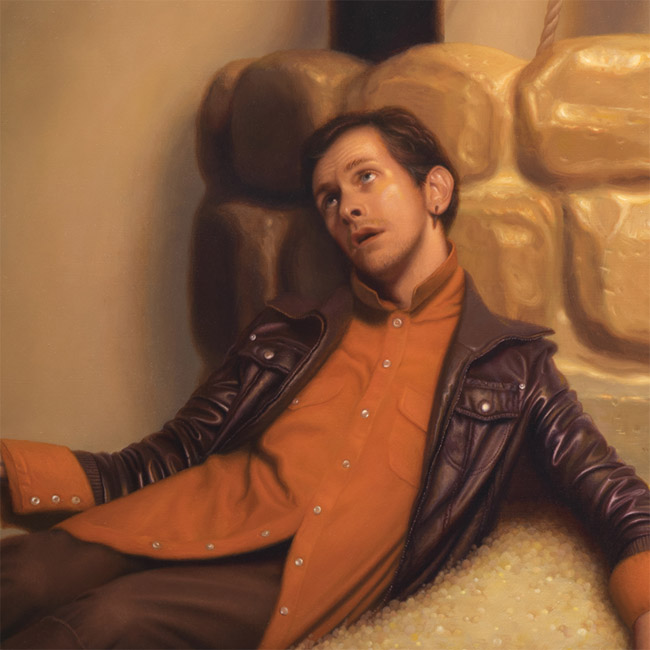 It is great how much we can tell about someone from their art. We leave ourselves open to be psychoanalyzed by anyone. As it has been said, “How we do one thing is how we do everything”. Whether or not that’s true I must say that I would trust a surgeon by the way that they butter their toast. I’m not sure if that information is available for patients.
It is great how much we can tell about someone from their art. We leave ourselves open to be psychoanalyzed by anyone. As it has been said, “How we do one thing is how we do everything”. Whether or not that’s true I must say that I would trust a surgeon by the way that they butter their toast. I’m not sure if that information is available for patients.
There is extraordinary skill in your work. Your rendering of difficult viewpoints, poses, expressions and details in every surface and object is remarkable and impressive. How do you achieve that? I read that you do drawings before beginning a painting, but do you spend a lot of time in preliminary drawing for a work? Particularly in capturing the figures. Perhaps you could give us an insight into your process as it is now.
Thank you kindly. That means a lot coming from a skilled artist. The main element to achieving ‘that’ is… wait for it…. time. Patience has been my greatest asset but it was also a bit of a curse in the beginning. I used to be so patient that I could have bottled it up and sold the excess if that was possible. Soon after my first couple of shows, I had to become faster. Now I see patience and speed as separate tools to be used on different parts of a painting.
Yes, I do spend a ton of time on preliminary work. Drawing is key. If one can draw they can learn to paint but it doesn’t always work the other way. I hate everything I do constantly until it starts to get better. I am stubborn like a thousand goats all packed into one being. I can’t stand to look at something until it begins to appear how I want it to. I have learned that the farther I go in the beginning stages of a painting (sketching, sculpting, photography, Photoshop, underpainting…) the easier if becomes towards the end, though that can be counter-intuitive.
Here’s an analogy to explain the counter-intuitive part: two people want to get from point A to B. One wants to walk and the other wants to drive a car. The first person starts walking right away and feels like they are in the lead, making progress faster. The second one has to look for their keys, wipe the dead leaves off of the windshield, open the door, adjust the seat, fasten the seat belt, start the car and set the temperature controls. By this time the first person is a few hundred meters down the road. Two minutes later, the second person passes them and ends up going a hundred times further. I used to be the first person. I thought the fastest way to paint this way was to get started as soon as possible. I was wrong. Adequate preparation makes it possible to go so much further and to have enough stamina for the final colour stages. They definitely knew that very well in previous centuries.
What part of your creative process do you enjoy the most and what challenges you the most?
Ideas. New ideas. I’m addicted to them. I can’t get enough. My intentions are large (in terms of scope more than scale), too vast and impossible. I will never get through them all but the hope keeps me going and gets me up in the morning. The challenge is more with the general overall time-management of life more than art management at this point. That is a good thing I guess. Could be much worse.
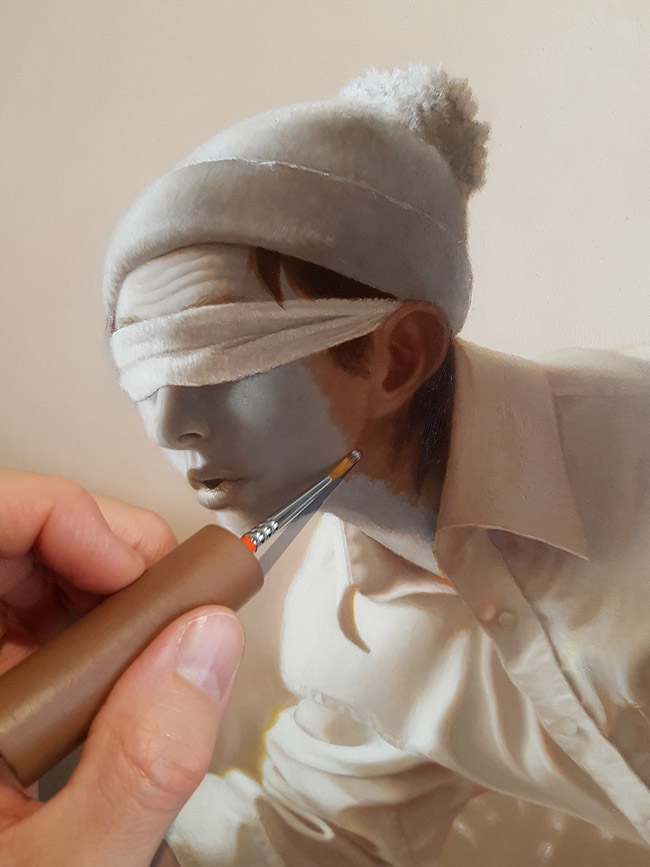 And now just a few questions concerning the Beautiful Bizarre Magazine Art Prize:
And now just a few questions concerning the Beautiful Bizarre Magazine Art Prize:
What was the process like for you? Did it meet your expectations?
I felt that the process was extremely easy because it was a non-acquisitional competition. The piece that I entered (my strongest current work) was only available as an online image so my submission would not have been possible if I had to send a physical artwork. In short, I would have to say that my expectations were exceeded. I do not generally don’t hold my breath when it comes to competitions so the news that I had become a finalist was a fabulous surprise. When I received honourable mention, my expectations where exceeded that much further.
Why did you enter the Beautiful Bizarre Magazine Art Prize?
In this business, I think that an artist has to do as much as they can to gain exposure. That being said, there are only so many art prizes available for each respective genre. Much of the world’s top talent is producing artwork that publicly funded institutions would not support with grant money and therefore it is vital for those artists, that contests like this exist.
I entered this contest because I had seen that Beautiful Bizarre Magazine has a strong online presence; the most important factor that many established brick and mortar galleries have foolishly overlooked.
Side note: I have spoken directly to galleries who blatantly dismiss the importance of social media as if it isn’t necessary to have an Instagram account for future business growth. In the meantime, they may be able to survive from their established collectors from the past, but the children of these collectors who will inherit all of that wealth are currently spending half of their time on Instagram. Just sayin’ 😉
What do you feel you have gained from this experience?
It was invaluable to see my work alongside the other international finalists. Today, a collection of jpeg’s side by side on a screen is akin to the Paris salons of the eighteenth century. It is a rare and special occasion to see a properly curated, top-rate collection of current work in one place. As computers and smartphones continue to increase in prevalence, the onscreen collection is becoming more and more important. If I had been able to make it to the opening at Modern Eden Gallery this September, the experience would have undoubtedly been taken to the next level. I look forward to going to Modern Eden in the new year.
Would you recommend it and encourage others to enter? If so, why?
I would of course. I think that it is easy for artists to enter this competition. They have nothing to lose. If they had to spend a lot of money shipping their work to be judged, it would be more difficult for entry.
Finally, what has Steve Chmilar got coming up in the following months.
Well. I have a couple of group shows on the calendar. The first one is the Beautiful Bizarre curated exhibition of the 20 finalists from the Inaugural Art Prize to be held at Modern Eden Gallery in December through January.
The exhibition is titled ‘Representational Modern’, and my painting, ‘Blue#minor7th’ is a continuation of my experiments with clay reference models. I relish in the delight of creating the illusion of a tactile, three-dimensional space on a two-dimensional surface, in a flat, smooth painting style. In previous works, I had used clay models as stand-ins that were intended to be replaced, but in this painting, I wanted to use clay as the main subject matter. By enveloping the figure, I have played with the idea that the background material and the human figure are part of each other rather than separate. The title is a reference to the connection of multiple senses known as synesthesia. It is 20 x 20 inches, oil on aluminium panel.

“BLUE#MINOR7TH” 2018
[Oil on aluminium, 20 x 20″]
@ Modern Eden Gallery
The second is an exhibition of Pop Surrealists, curated by Marie Larkin, at Weswal Gallery, in Australia. As well, I have a couple of good indoor fairs that I might do here in Canada. One in Toronto and one in Vancouver.
I will be teaching more as well. I have a two-session workshop in Victoria BC, Canada coming up and thankfully they are both already full. I always look forward to interacting with people, which is so important for an ambivert who’s career choice has them spending so much time alone. My patient personality makes me very comfortable in a teaching environment and gives me the ability to put students at ease.
I had a great voice teacher when I was a teenager that influenced me in terms of teaching style. He was so encouraging and would always explain things in many different ways to get difficult concepts across. I do the same with painting. There are many ‘meta’ concepts in art that require different explanations for each individual and I enjoy seeing the ‘ah-ha’ moments on people’s faces when they finally get it.
Other than that, I just moved from an apartment in downtown Toronto to a beautiful coastal location in a small town on Vancouver island, so it is quite a nice change. I grew up on a farm and so it is nice to get back to nature and have more space to work on multiple projects at once. My new studio has already been well used.
In closing, I would like to thank you for this interview, Marie. It is a great honor.
Republished from Beautiful Bizarre Magazine.


